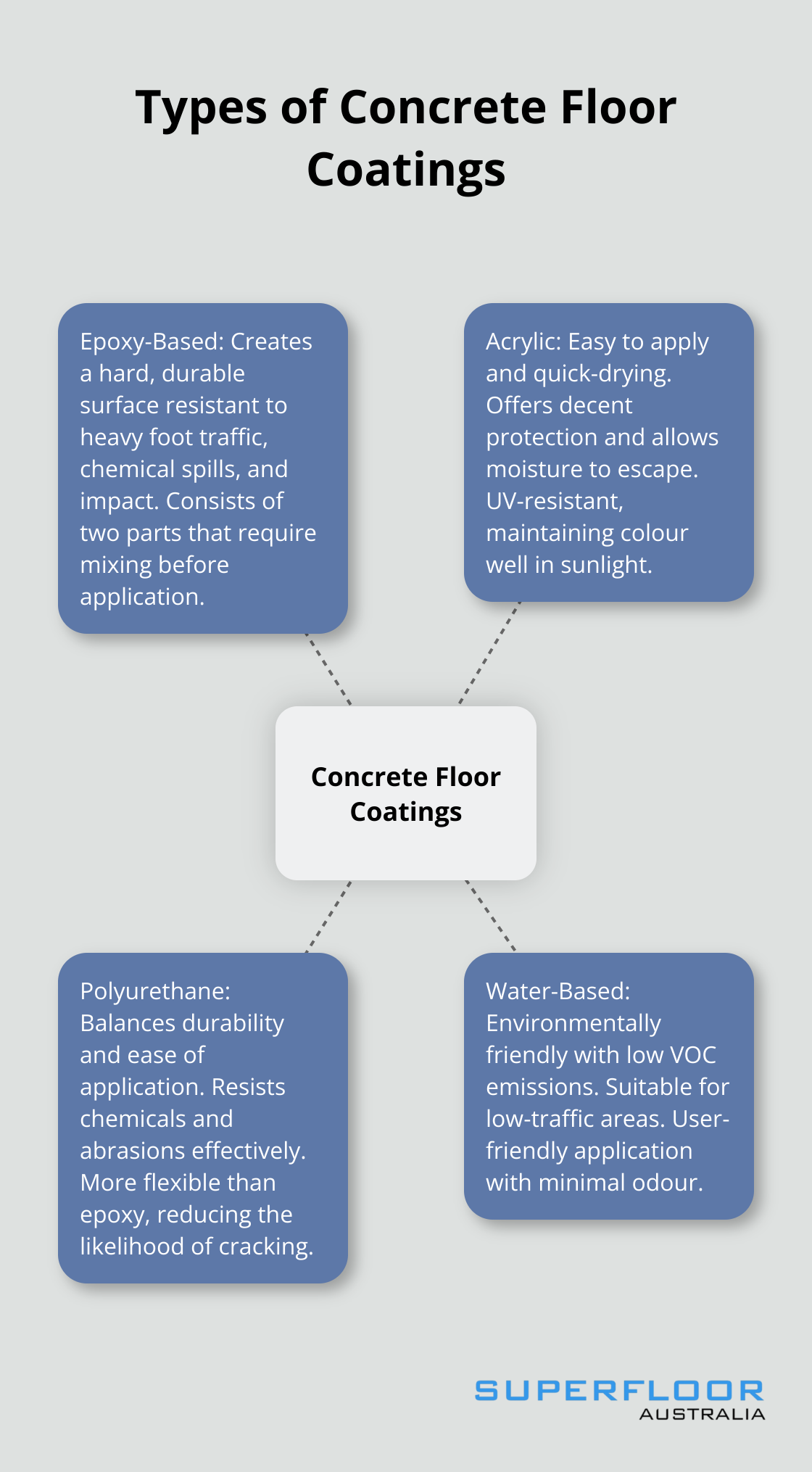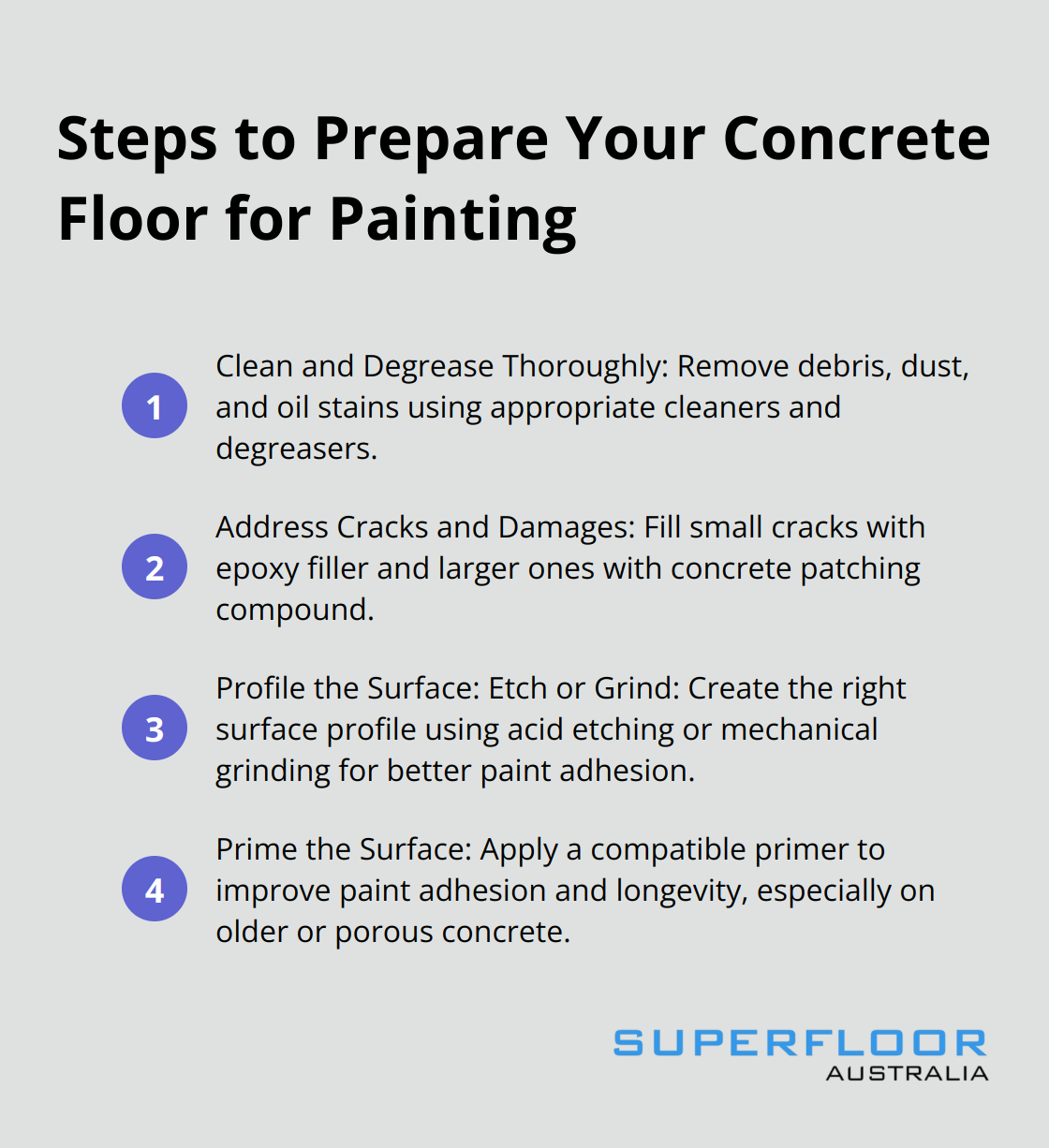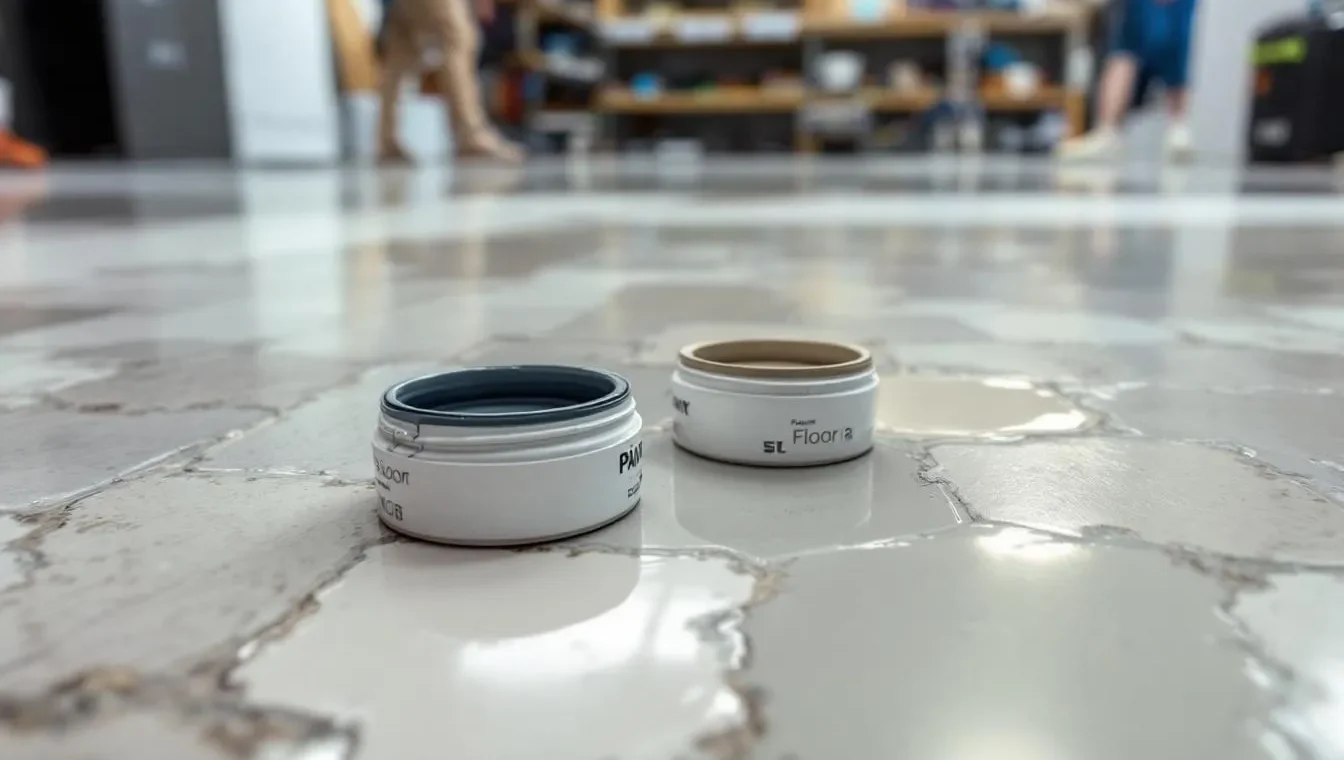Choosing the best floor paint for concrete can be a daunting task. With numerous options available, it’s essential to understand the different types and their unique properties.
At Superfloor Australia, we’ve seen first-hand how the right paint can transform a dull concrete floor into a stunning, durable surface. This guide will help you navigate the selection process and ensure you pick the perfect paint for your specific needs.
Types of Concrete Floor Paint
At Superfloor Australia, we often receive questions about the various types of concrete floor coatings available. While we specialise in polished concrete flooring, we understand that coatings can be a viable option for certain situations. Let’s explore the main types of concrete floor coatings you’ll find in the market.

Epoxy-Based Coatings
Epoxy-based coatings stand as the heavyweight champions of concrete floor coatings. They create a hard, durable surface that resists heavy foot traffic, chemical spills, and impact. These protective coatings are used to prevent corrosion.
These coatings consist of two parts that require mixing before application. The chemical reaction between these components results in a tough, plastic-like finish. However, the application process can prove challenging, and the fumes during curing can be strong (proper ventilation is essential).
Acrylic Coatings
Acrylic coatings appeal to DIY enthusiasts due to their easy application and quick drying time. They offer less durability than epoxy but still provide decent protection against wear and tear. Acrylic coatings allow moisture to escape from the concrete, which benefits certain environments.
One advantage of acrylic coatings is their UV resistance. Unlike epoxy, which can yellow over time when exposed to sunlight, acrylic maintains its colour well. This makes it a suitable option for outdoor concrete surfaces or areas with abundant natural light.
Polyurethane Coatings
Polyurethane coatings strike a balance between epoxy and acrylic in terms of durability and ease of application. They resist chemicals and abrasions effectively, making them appropriate for garage floors or industrial settings. Polyurethane also offers more flexibility than epoxy, reducing the likelihood of cracking if the underlying concrete shifts slightly.
The Concrete Network provides information on selecting proper materials, evaluating the surface, material properties, and application procedures for concrete floor coatings.
Water-Based Coatings
Water-based coatings represent the most environmentally friendly option, with low VOC emissions and simple clean-up. While not as durable as other types, they suit low-traffic areas or situations where frequent recoating isn’t problematic.
These coatings are particularly user-friendly, as they don’t require mixing and produce minimal odour during application. However, they may not adhere as well to smooth concrete surfaces, so proper preparation becomes key to achieving a lasting finish.
While coatings offer a quick fix for concrete floors, it’s worth noting that for long-term durability and low maintenance, polished concrete solutions often yield superior results. Further, polished concrete never requires the use of wax or sealers, so they are not only durable but also low maintenance.
Now that we’ve covered the main types of concrete floor coatings, let’s move on to the factors you should consider when making your selection. These considerations will help you choose the best coating for your specific needs and ensure a successful application.
What Factors Matter Most When Selecting Concrete Floor Paint?

Traffic and Wear Patterns
The amount and type of traffic your floor will endure should top your list of concerns. Heavy foot traffic, vehicle movement, or frequent equipment use demand more durable coatings. Epoxy-based paints excel in high-traffic industrial settings, withstanding constant abuse. Acrylic coatings might suffice for residential spaces with lighter use.
A study by the National Floor Safety Institute found that properly chosen floor coatings can reduce slip-and-fall incidents by up to 21%. This statistic highlights the importance of selecting a coating that maintains its integrity under your specific traffic conditions.
Chemical Exposure and Stain Resistance
If your floor will face exposure to chemicals, oils, or other potentially staining substances, prioritise coatings with high chemical resistance. Polyurethane coatings have a much more comprehensive range of chemical resistance compared to epoxy coatings, making them superior for protection against a wide range of chemicals and stains.
In a recent project for a local auto repair shop, a high-grade epoxy coating proved its worth. Six months after application, the floor showed no signs of degradation despite daily exposure to motor oil and various automotive fluids.
Moisture Levels and Vapour Transmission
Concrete’s porous nature means moisture can become a significant issue. Water-based coatings allow moisture to escape, making them suitable for areas with higher humidity or potential ground-water issues. If you’re dealing with a basement or ground-level floor, use a moisture meter to assess vapour transmission rates before selecting your coating.
The most basic test for measuring concrete readiness is ASTM D4263-05, Standard Test Method for Indicating Moisture in Concrete by the Plastic Sheet Method. Always check manufacturer specifications for moisture tolerance levels.
Ease of Application and Maintenance
Some coatings (like water-based options) offer easier application, which can be a significant factor for DIY enthusiasts. Consider the complexity of the application process and the tools required. Also, think about long-term maintenance requirements. Some coatings need regular reapplication, while others (like epoxy) can last for years with minimal upkeep.
Aesthetic Options and Finishes
The visual appeal of your floor matters. Different coatings offer various aesthetic options, from high-gloss finishes to matte looks. Some allow for colour customisation or the addition of decorative flakes. Consider how the coating’s appearance will complement your space’s overall design.
While coatings can provide a quick solution, it’s worth noting that polished concrete takes plain concrete to a whole new level of refinement. Through a process of grinding, honing, and polishing the surface, a sleek and glossy finish is achieved.
The next step in your concrete floor journey involves proper preparation. Let’s explore how to ready your surface for the perfect paint application, ensuring optimal adhesion and longevity for your chosen coating.
How to Prepare Your Concrete Floor for Painting
Proper preparation is the foundation of a successful concrete floor painting project. We at Superfloor Australia have witnessed many DIY attempts fail due to inadequate surface preparation. Here’s how to prepare your concrete floor for painting.

Clean and Degrease Thoroughly
Start by removing all debris, dust, and loose particles from the floor. Use a powerful industrial vacuum cleaner for best results. Next, tackle any oil or grease stains. A degreaser specifically designed for concrete works best. Apply it generously to affected areas and scrub with a stiff-bristled brush. Rinse thoroughly and allow the floor to dry completely.
For stubborn stains, you might need to repeat this process. Used engine oil can impact the compressive strength of concrete, so persistence pays off.
Address Cracks and Damages
Inspect your floor for cracks, chips, or spalling. Fill small cracks (less than 1/8 inch wide) with an epoxy filler. For larger cracks, use a concrete patching compound. Always follow the manufacturer’s instructions for mixing and application.
Allow all repairs to cure fully before proceeding. This typically takes 24 to 48 hours, depending on the product used and environmental conditions.
Profile the Surface: Etch or Grind
Creating the right surface profile is essential for paint adhesion. For most residential applications, acid etching suffices. Use a muriatic acid solution (following safety precautions) to open up the pores of the concrete.
For commercial or industrial floors, or when dealing with particularly smooth concrete, mechanical grinding becomes necessary. This process removes the top layer of concrete, creating a rougher surface for better paint bonding.
The International Concrete Repair Institute (ICRI) has established concrete surface profile (CSP) standards, ranging from CSP 1 (nearly smooth) to CSP 9 (very rough). Most floor coatings require a profile between CSP 2 and CSP 3.
Prime the Surface
While not always necessary, priming can significantly improve paint adhesion and longevity, especially on older or more porous concrete. Choose a primer compatible with your selected paint type.
Apply the primer using a roller with a 3/8-inch nap, ensuring even coverage. Allow it to dry completely before applying your chosen floor paint.
Take your time and follow these steps meticulously. Rushing through preparation often leads to disappointing results. A well-prepared surface (free of contaminants and properly profiled) creates the perfect canvas for your concrete floor, ensuring a long-lasting and beautiful finish.
Final Thoughts
Choosing the best floor paint for concrete requires careful consideration of durability, chemical resistance, and application ease. Epoxy-based coatings excel in high-traffic areas, while acrylic and water-based options suit DIY projects. Polyurethane provides a balance between durability and user-friendliness, making it versatile for various applications.
Proper preparation forms the foundation of a successful concrete floor painting project. Thorough cleaning, crack repair, and surface profiling ensure optimal paint adhesion and longevity. These steps (often overlooked) can save time and money in the long run.
While paint offers an effective solution for many concrete floors, other options exist. Polished concrete flooring provides a durable, low-maintenance alternative that enhances concrete’s natural beauty without coatings. We at Superfloor Australia specialise in this option, which offers excellent longevity for both residential and commercial spaces.
